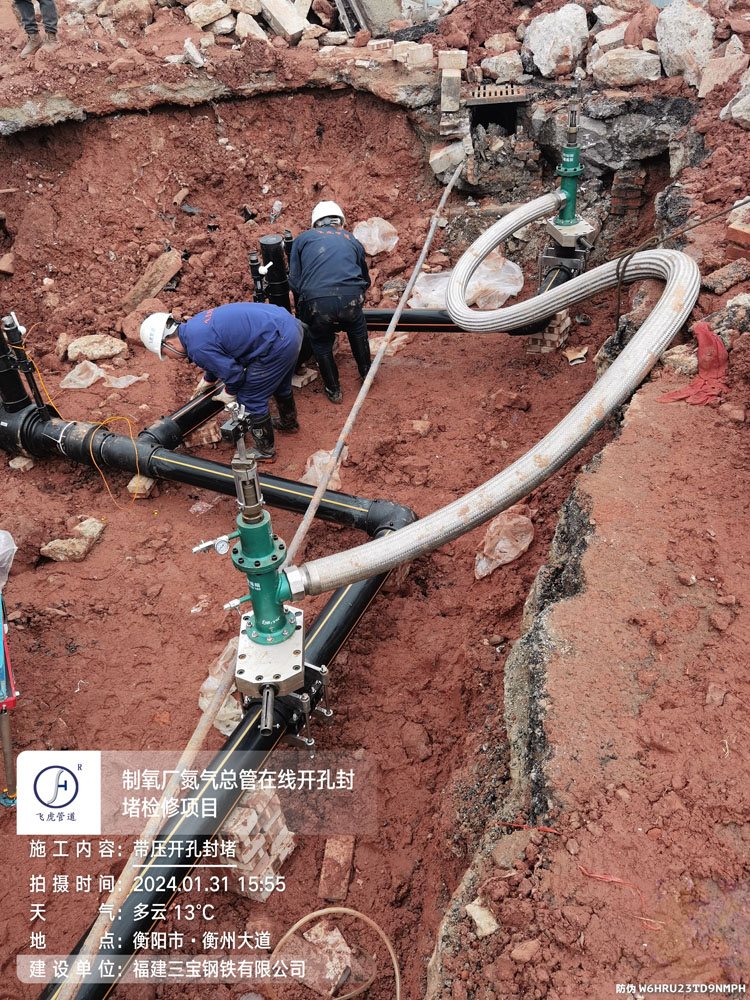Understanding PE Hot Tapping for HDPE Pipelines
PE Hot Tapping for HDPE Pipelines is a specialized technique that allows new connections to be made to existing pipelines without interrupting the flow of product. This process is especially important in industries where continuous service is essential, such as gas, water, and oil distribution networks. Unlike traditional pipeline modifications that require a full system shutdown, hot tapping provides a safer, faster, and more efficient way to expand or repair pipelines. The method involves drilling into a live pipeline under pressure using advanced tapping equipment designed for polyethylene systems. This ensures that maintenance or expansion tasks can be completed without disrupting operations or compromising pipeline integrity. By eliminating the need for shutdowns, companies can save both time and operational costs while keeping service uninterrupted. As HDPE pipelines continue to be widely adopted for their strength and flexibility, hot tapping has become a critical solution for modern infrastructure needs.
How the PE Hot Tapping Process Works
The process of PE Hot Tapping for HDPE Pipelines begins with the installation of a specially designed tapping saddle on the pipeline. This saddle acts as a secure connection point, allowing a tapping machine to be mounted safely. Once the setup is in place, a valve is attached to control flow during and after the operation. A cutter is then used to bore into the pipeline wall while maintaining full system pressure, ensuring that the flow of gas, water, or oil is not interrupted. The removed material, called the coupon, is retained for safety and inspection. Once the tap is complete, the valve remains in place, allowing new branch lines or fittings to be connected directly to the live pipeline. This method works with various pipeline diameters and pressure ratings, making it versatile for a wide range of applications. Safety monitoring and pressure control are vital throughout the procedure to ensure reliability and precision.
Advantages of Using PE Hot Tapping for HDPE Pipelines
There are numerous benefits to using PE Hot Tapping for HDPE Pipelines, making it a preferred method for live system maintenance. One of the primary advantages is the ability to perform modifications without shutting down the pipeline, which minimizes downtime and ensures uninterrupted service. This is particularly valuable for industries where stopping the flow would result in significant financial losses or service disruptions. Another key benefit is cost efficiency, as companies avoid the expenses associated with system shutdowns and restarts. The process also protects the structural integrity of HDPE pipelines by using fittings and techniques that maintain long-term durability. Environmental safety is another advantage, as the controlled operation reduces the risk of leaks, spills, or contamination during maintenance. The flexibility of PE hot tapping also makes it suitable for both emergency repairs and planned expansions. With its combination of efficiency, safety, and adaptability, hot tapping continues to gain recognition as an essential pipeline maintenance method.
Key Applications Across Industries
PE Hot Tapping for HDPE Pipelines is used in a wide variety of industries that require dependable and efficient service. In natural gas distribution, it allows utilities to expand their networks or repair sections without shutting off supply to customers. Water utilities rely on hot tapping to make new connections, add service lines, or repair pipelines without disrupting communities that depend on continuous water access. In the oil and chemical industries, hot tapping provides a reliable method for working with high-pressure systems that transport valuable resources. Industrial plants and manufacturing facilities also use the method to expand production lines or reroute utilities without halting operations. Infrastructure projects benefit from hot tapping when integrating new pipelines into existing networks. Emergency situations, such as repairing damaged sections of pipeline, also call for hot tapping because of its ability to isolate and address issues quickly. This wide range of applications highlights its versatility and critical role in modern pipeline management.
Choosing a Reliable PE Hot Tapping Service Provider
Selecting the right service provider for PE Hot Tapping for HDPE Pipelines is crucial to ensure safe and efficient operations. A qualified provider should employ certified technicians with specialized training in live pipeline maintenance and hot tapping procedures. The use of advanced equipment is also essential, as precision tools and high-quality fittings are necessary to maintain pipeline integrity. Compliance with safety standards and industry regulations should be a top priority when evaluating providers. Companies should also consider the service provider’s track record, including experience working with HDPE pipelines in different industries. Providers that offer customized solutions for various pipeline diameters, pressures, and operational needs demonstrate a higher level of expertise. Reliable providers also ensure proper inspection, testing, and quality control before and after the hot tapping procedure. Partnering with a skilled and experienced provider minimizes risks and guarantees that the hot tapping process is carried out smoothly and safely.
Safety Considerations and Best Practices in PE Hot Tapping
Safety is at the core of every PE Hot Tapping operation for HDPE pipelines. Since the procedure involves working on live pipelines under pressure, strict safety measures must be followed to protect both personnel and infrastructure. Proper training and certification for technicians are essential, as handling specialized equipment requires skill and precision. Monitoring pipeline pressure before, during, and after the operation helps prevent unexpected issues. Regular inspection and maintenance of tapping machines, valves, and saddles are critical to ensure they perform reliably in the field. Best practices also include coordinating between safety officers and technicians to manage risks effectively. Environmental safety is another key factor, with protocols in place to prevent leaks or contamination during operations. By adhering to these practices, companies can ensure that PE hot tapping operations are carried out with the highest standards of safety and reliability.
Innovations and Future Trends in PE Hot Tapping for HDPE Pipelines
Technological innovations are enhancing the effectiveness and safety of PE Hot Tapping for HDPE Pipelines. Modern tapping equipment is designed with stronger materials and improved sealing capabilities to handle higher pressures more reliably. Automation and digital monitoring are being introduced to improve accuracy and reduce human error during operations. Some service providers are implementing remote monitoring systems, allowing supervisors to track pressure and performance in real time. New fittings and saddles are being developed to create longer-lasting connections that support expanding pipeline networks. As HDPE materials evolve, their improved strength and flexibility are enabling hot tapping operations on larger and more demanding systems. The future of PE hot tapping is also closely tied to sustainability, with advancements aimed at reducing waste, minimizing environmental risks, and supporting efficient infrastructure growth. These innovations will ensure that hot tapping continues to be a critical solution in the pipeline industry for decades to come.
Frequently Asked Questions (FAQ)
What types of pipelines are suitable for PE hot tapping?
PE hot tapping is most effective for HDPE pipelines, but it can also be applied to systems carrying gas, water, oil, and certain chemicals.
Can PE hot tapping be used on high-pressure HDPE pipelines?
Yes. With advanced equipment and proper safety protocols, hot tapping can be safely performed on high-pressure HDPE systems.
How long does a typical PE hot tapping operation take?
The duration varies depending on pipeline size and conditions, but hot tapping is generally faster than shutting down and restarting the system.
Is hot tapping more cost-effective than traditional pipeline modifications?
Yes. By avoiding system shutdowns, hot tapping reduces downtime, labor costs, and production losses, making it a more cost-effective option.
What safety precautions are necessary during PE hot tapping?
Key precautions include certified technicians, continuous pressure monitoring, proper use of tapping equipment, and strict adherence to safety regulations.

